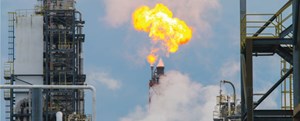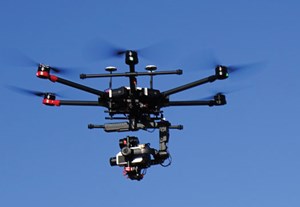A progressive approach: Why the Permian basin tells us all we need to know about methane emissions management
I started my career in healthcare—a long way from the Permian basin and reducing methane emissions. And although very different, healthcare and energy and industrials have important similarities: they both allow you to make a positive difference, problem-solve on key challenges, and do work that ultimately improves lives.
Like healthcare, managing methane emissions is essential. Cutting methane emissions is predicted to be the quickest way that we can slow the rate of climate change. The warming potential of methane has been shown to be 84 times that of carbon dioxide over a 20-year period, along with being the second-largest cause of global warming.1,2
With COP26 fast approaching, many countries are now upping the ambitions of their climate targets, and cutting methane emissions is high on regulators’ agendas. The European Union is focusing on a plan to reduce methane emissions 37% by 2030, compared to 2005 levels. Similarly, President Joe Biden recently announced a new target for the U.S. to achieve a 50%-to-52% reduction from 2005 levels in economy-wide net greenhouse gas pollution by 2030.
This emerging regulatory environment presents a notable challenge for the oil and gas industry, estimated by the IEA to have emitted 82 MMt (around 2.5 GtCO2-eq) of methane in 2019. A failure to meaningfully address methane emissions threatens to undermine the value of natural gas in a low-carbon future and to impact the industry’s social license to operate. However, this environment offers a notable opportunity, too, for the sector to show its commitment to protecting the planet while also preserving the bottom line.3
THE FLARING challenge
One of the most visible manifestations of methane emissions in oil and gas is flaring. It’s also an area where companies can make the most impact. Yet, simply turning off flares is not an option; flares burn flammable gases that would otherwise be released into the atmosphere and are an essential safety feature. Instead, operators need to focus on reducing flaring and optimizing flare efficiency.
Many oil and gas companies are already doing a lot to accomplish this, regardless of the regulatory environment. A good example is taking place in the Permian basin—one of the most important oil provinces in the world and the source, according to the Environmental Defense Fund, of 1.4 MM metric tons of methane generated each year. That’s enough gas to meet the annual needs of nearly 2 million homes.
Here, market-leading operators and our customers are taking action and committing to reducing their methane intensities. To do this successfully, these companies are changing how methane emissions are monitored, measured and reduced. And the Permian basin’s prolific well count makes it an ideal place for businesses like ours to identify and develop best practices.
For us, this means a shift from the traditional approach to measuring methane— teams working manually on an ad-hoc basis, often in potentially hazardous conditions—to deploying cutting-edge digital technology developed by our business.
Baker Hughes’ technologies and solutions—Avitas LUMEN and Panametrics flare.IQ— allow operators to implement highly targeted emissions reduction strategies and give them highly accurate and actionable data, creating more efficient operations.
AVITAS SOLUTIONS
Avitas LUMEN provides a full suite of methane detection, quantification and localization solutions. The platform consists of two seamlessly connected formats: a ground-based solar-powered wireless sensor network (LUMEN Terrain), and a drone-based system for over-air inspection (LUMEN Sky). These items ensure that methane emissions are monitored as efficiently and accurately as possible, in real time.
LUMEN Sky uses drone-mounted infrared cameras that capture images of methane plumes, which are then analyzed by AI to identify problem spots, Fig. 1. This technology can survey about 500 acres in 15 minutes, potentially visiting 30 to 50 sites per day. It can catch leaks as small as 2 standard cubic feet per hour. It also provides powerful AI-driven analytics with interactive, 3D, digital twin visualization.
One example of the difference that this technology can make is from one of our key customers in the Permian basin. This operator places a high priority on combating methane emissions linked to oil and gas production in the region, and has announced a target to keep methane emissions intensity for operated assets below a certain threshold, within the next few years. Working with LUMEN Sky technology, this operator is realizing the potential of drone-based technology to focus on more efficient detection and reporting of leaks in the Permian. Moreover, for the firm’s future operations, drones deployed in higher altitudes could enable detection over a larger area and an increased number of sites, providing further efficiency gains. This, in turn, will enable much quicker repair of leaks, reducing methane emissions and the related global warming impact.
Avitas also has a ground-based continuous monitoring system, LUMEN Terrain, which is a solar-powered, wireless system that creates a “digital mesh” network around a facility. The Terrain sensors capture data every 4 sec, 24 hours per day, allowing operators to access an unparalleled level of actionable data. This enables companies to make predictive changes and pinpoint the sources of emissions, so they can deploy timely solutions to mitigate issues.
FLARE.IQ SOLUTION
Both of these technologies can be combined with another Baker Hughes solution for methane emissions, Panametrics’ flare.IQ. Using the technology and its advanced analytics platform, operators can understand critical information about their flare systems, including temperature, pressure, vent gas velocities and gas composition, to determine the optimum levels of flare performance and ensure 98%+ high-efficiency flare combustion.
By optimizing flare operations and reducing methane slip emissions, operators are increasingly turning to flare.IQ to help deliver ever more ambitious decarbonization targets.
BP, for example, is using flare.IQ to help it measure and address methane emissions from flaring. First tested at a BP-operated location in the North Sea, the technology now forms part of the company’s methane measurement approach being rolled out under its Aim 4—to install methane measurement on all major oil and gas processing facilities by 2023.
With our company’s technologies and digital solutions, oil and gas companies in the Permian basin are driving change—adopting technologies that not only reduce fuel and operational costs, but that also help reduce emissions and protect the planet. It’s a progressive approach, and one that can be adopted across all oil and gas sites, no matter the infrastructure or terrain.
As global pressure to tackle climate challenges intensifies in the coming years, either through regulation, public pressure or greater climate disclosure from operators, we expect that other regions will want to learn from what is going on in the Permian basin. This could be in Russia, the Middle East or elsewhere.
Reducing methane emissions is a big challenge for the oil and gas sector. What the Permian Basin is showing us is the key role that innovative, data-led monitoring technologies can play in reducing and eventually eliminating methane emissions.
I started my career in healthcare, because I believed in the difference that technology could make in saving lives. Now I am motivated by the knowledge that emission management technology is playing a key role in helping to meet our global climate goals.
REFERENCES
- https://www.epa.gov/gmi/importance-methane#:~:text=Methane%20is%20the%20second%20most,trapping%20heat%20in%20the%20 atmosphere
- https://www.epa.gov/ghgemissions/understanding-global-warming-potentials
- https://www.iea.org/reports/methane-emissions-from-oil-and-gas

- Production technology: How a minor instrument upgrade led to major oil separator savings (November 2025)
- Executive viewpoint: Investing in existing oil & gas fields is key to energy security and net-zero goals (November 2025)
- What LNG and AI mean for drilling in 2030 (November 2025)
- Water management: The New Mexico soap opera (November 2025)
- Engineered components are the difference between survival and failure in HPHT subsea systems (November 2025)
- Industrial Intelligence: At Weatherford, data drives the bit and everything after (October 2025)
- Subsea technology- Corrosion monitoring: From failure to success (February 2024)
- Applying ultra-deep LWD resistivity technology successfully in a SAGD operation (May 2019)
- Adoption of wireless intelligent completions advances (May 2019)
- Majors double down as takeaway crunch eases (April 2019)
- What’s new in well logging and formation evaluation (April 2019)
- Qualification of a 20,000-psi subsea BOP: A collaborative approach (February 2019)




